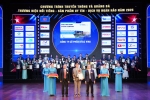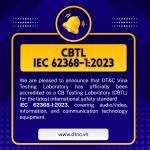[Guinea] Request samples for ARTP local testing
From March 25, 2023, the Postal and Telecommunications Regulatory Authority (ARPT) of the Republic of Guinea has announced that sample tests will be run at ARPT test laboratories. Sample units submitted for approval must be supplied with all accessories required for testing in addition to a test report from an accredited testing laboratory. Failure to do so may result in your application being rejected.
[Hong Kong] New regulations for 5G wireless equipment
According to the Hong Kong Telecommunications Authority (OFCA), the new Type Approval Criteria Regulation for 5GNR repeater equipment operating below 6 GHz, corresponding to standard number TAC 012. ISSUE 1. MARCH 2023, will come into effect on 28 March 2023.
[Papua New Guinea] State Gazette, type approval, communication rules and QoS
The Papua New Guinea National Information and Communications Technology Authority (NICTA) has issued a notice on a new regulatory instrument, ICT Equipment Type Approval Rules 2022.
The rule aims to ensure that only type-approved ICT equipment is deployed, sold or used in Papua New Guinea, and establishes minimum technical regulatory requirements and administrative procedures for imported ICT equipment.
The type approval certificate is valid for 3 years. This change will take effect on February 2, 2023.
[Peru] MTC announces TAC requirements for WWAN equipment
The Peruvian Ministry of Transport and Communications (MTC) published the TAC requirements for type approval applications for WWAN devices on January 6, 2023. For the use of TACs assigned by the GSMA to WWAN devices, previously only accepting TACs for off-the-shelf products, we now accept TAC approvals for WAN modules.
[Saudi Arabia] CTS Announces License for Special Wireless Network in 450 MHz Band
Saudi Arabia's Telecommunications and Space Technology Authority (CST) has issued an Information Code for Special Radio Network Licenses for 450 MHz to continue its plans to implement Spectrum Outlook for commercial and innovative uses.
The main objectives of that special wireless network license definition are:
- Allocate 450MHz wireless license to build a nationwide network
- Establishment of a national shared business wireless network that provides improved technology and services to various users
- Reduce or eliminate congestion currently occurring in the 400 MHz band by using a more efficient shared system
- Meeting the needs of all users, from important national users such as oil and mining entities to small regional users
- Offer reasonable prices for services
The content is contained in the “Information Code for Special Telecommunications Only Frequency License in the 450 MHz Band”, and the application deadline for eligible applicants is July 9, 2023.
[Thailand] NBTC Announces BNTC TS 1039-2566 Telecommunications Equipment Standard for Permission to Use 5.925-6.425 GHz Frequency and Technical Standard for Use
On April 28, 2023, NBTC announced the 5.925-6.425 GHz frequency license standard and technology standard for use, BNTC TS 1039-2566 Telecommunications Equipment. The contents will come into effect from the 29th of the same month. The required certificates are as follows:
1. RF test report based on FCC Part 15.407 (ETSI EN not acceptable)
Below are the mandatory exam provisions:
a. Maximum output power:
| Frequency (GHz) |
Maximum e.i.r.p Output power (m/W) |
Maximum e.i.r.p Output power (m/W) |
Apply to |
| 5.925 - 6.425 |
250 |
24 |
Inside |
| 25 | 14 | Inside & Outside |
b. Maximum power spectral density:
| Frequency (GHz) |
Maximum power spectral density (mW/MHz)
|
Maximum power spectral density (mW/MHz)
|
Apply to |
| 5.925 - 6.425 |
12.5 |
11 |
Inside |
| 1.25 | 1 | Inside & Outside |
c. channel bandwidth
d. Regulation standards for unnecessary emissions
e. in-band noise (radiation mask)
f. contention based protocol
Note: Access points with an output power greater than 25 mW (eirp) but not greater than 250 mW (eirp) must not be powered by battery power.
EMF or SAR test report (EMF/SAR test report can be waived for indoor/outdoor use at 25mW)
Electrical safety test report. Ex) IEC60950-1, IEC62368-1 or TIS 62368-1
Among products that belong to Class A or B (e.g. mobile phones with 4G/5G+wifi) and were previously approved without 6GHz, if 6GHz is added later, a new type approval certificate must be issued and the model number is different from the existing model number. need to change For products approved with SdoC without 6GHz (eg 2.4 or 5GHz wifi), if 6GHz wifi is added after this, it will need to get a new SdoC and the model number can remain as the old one.
Source: dtnc.co.kr









![[MIC] Officially issued QCVN 134:2024/BTTTT - National technical regulation on specific absorption levels for handheld and body-worn radio devices according to Circular 19/2024/TT-BTTTT of Ministry of Information and Communications](https://cdn0577.cdn4s.com/thumbs/qcvn-134_thumb_150.jpg)



![[Latest] Circular 02/2024/TT-BTTTT regulating the List of potentially unsafe products and goods under the management responsibility of the Ministry of Information and Communications](https://cdn0577.cdn4s.com/thumbs/trang-huy-hieu-the-loai-logo-2_thumb_150.jpg)